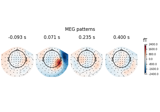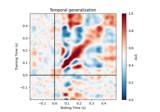mne.decoding.Vectorizer#
- class mne.decoding.Vectorizer[source]#
Transform n-dimensional array into 2D array of n_samples by n_features.
This class reshapes an n-dimensional array into an n_samples * n_features array, usable by the estimators and transformers of scikit-learn.
- Attributes:
- features_shape_
tuple Stores the original shape of data.
- features_shape_
Methods
fit(X[, y])Store the shape of the features of X.
fit_transform(X[, y])Fit the data, then transform in one step.
Get metadata routing of this object.
get_params([deep])Get parameters for this estimator.
Transform 2D data back to its original feature shape.
set_output(*[, transform])Set output container.
set_params(**params)Set the parameters of this estimator.
transform(X)Convert given array into two dimensions.
Examples
>>> from sklearn.linear_model import LogisticRegression >>> from sklearn.pipeline import make_pipeline >>> from sklearn.preprocessing import StandardScaler >>> clf = make_pipeline(Vectorizer(), StandardScaler(), LogisticRegression())
- fit(X, y=None)[source]#
Store the shape of the features of X.
- Parameters:
- Xarray_like
The data to fit. Can be, for example a list, or an array of at least 2d. The first dimension must be of length n_samples, where samples are the independent samples used by the estimator (e.g. n_epochs for epoched data).
- y
None|array, shape (n_samples,) Used for scikit-learn compatibility.
- Returns:
- selfinstance of
Vectorizer Return the modified instance.
- selfinstance of
- fit_transform(X, y=None)[source]#
Fit the data, then transform in one step.
- Parameters:
- Xarray_like
The data to fit. Can be, for example a list, or an array of at least 2d. The first dimension must be of length n_samples, where samples are the independent samples used by the estimator (e.g. n_epochs for epoched data).
- y
None|array, shape (n_samples,) Used for scikit-learn compatibility.
- Returns:
- X
array, shape (n_samples, -1) The transformed data.
- X
- get_metadata_routing()[source]#
Get metadata routing of this object.
Please check User Guide on how the routing mechanism works.
- Returns:
- routing
MetadataRequest A
MetadataRequestencapsulating routing information.
- routing
- inverse_transform(X)[source]#
Transform 2D data back to its original feature shape.
- Parameters:
- Xarray_like, shape (n_samples, n_features)
Data to be transformed back to original shape.
- Returns:
- X
array The data transformed into shape as used in fit. The first dimension is of length n_samples.
- X
- set_output(*, transform=None)[source]#
Set output container.
See Introducing the set_output API for an example on how to use the API.
- Parameters:
- transform{“default”, “pandas”, “polars”}, default=None
Configure output of
transformandfit_transform.“default”: Default output format of a transformer
“pandas”: DataFrame output
“polars”: Polars output
None: Transform configuration is unchanged
New in v1.4: “polars” option was added.
- Returns:
- self
estimatorinstance Estimator instance.
- self
- set_params(**params)[source]#
Set the parameters of this estimator.
The method works on simple estimators as well as on nested objects (such as
Pipeline). The latter have parameters of the form<component>__<parameter>so that it’s possible to update each component of a nested object.
- transform(X)[source]#
Convert given array into two dimensions.
- Parameters:
- Xarray_like
The data to fit. Can be, for example a list, or an array of at least 2d. The first dimension must be of length n_samples, where samples are the independent samples used by the estimator (e.g. n_epochs for epoched data).
- Returns:
- X
array, shape (n_samples, n_features) The transformed data.
- X
Examples using mne.decoding.Vectorizer#

Linear classifier on sensor data with plot patterns and filters

